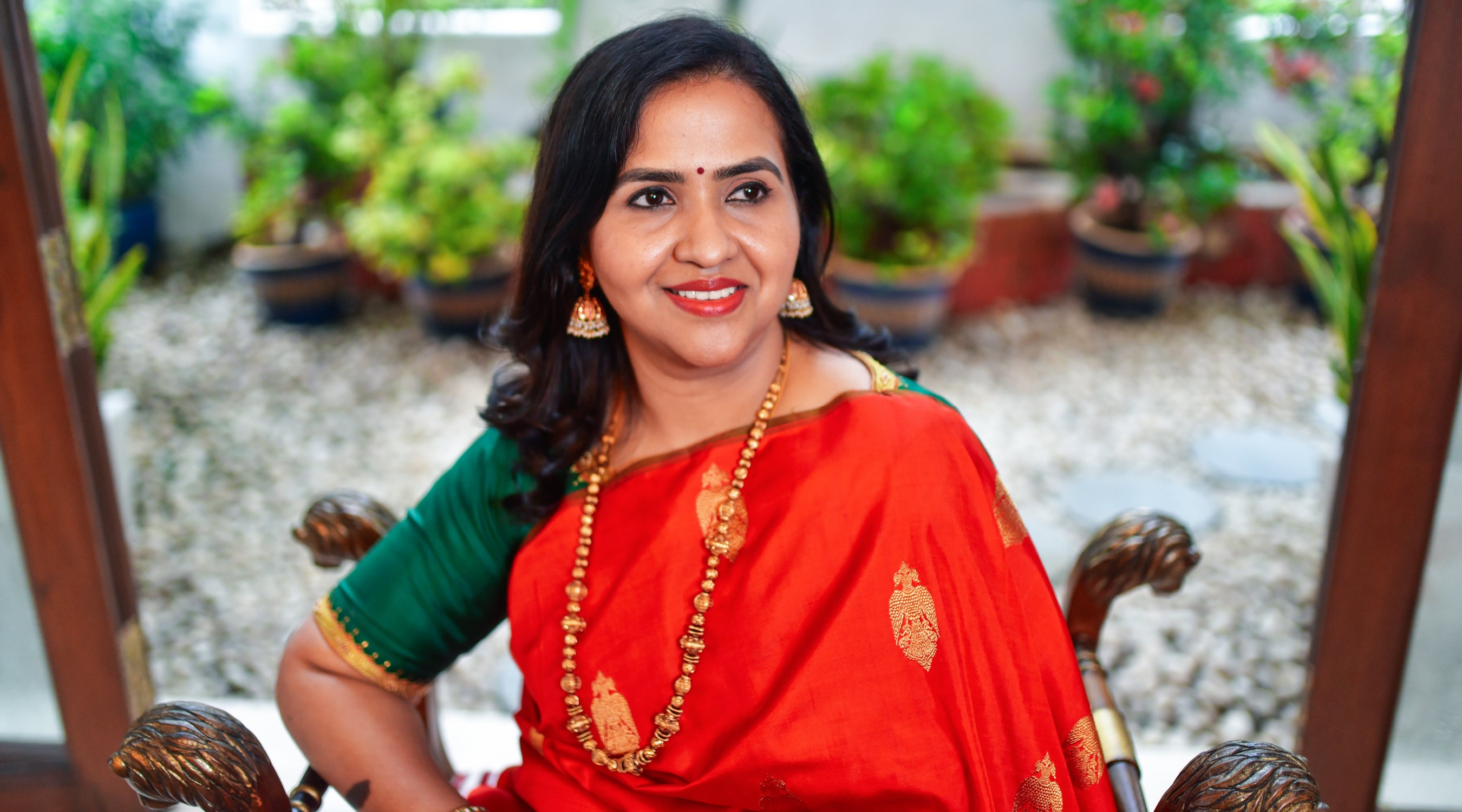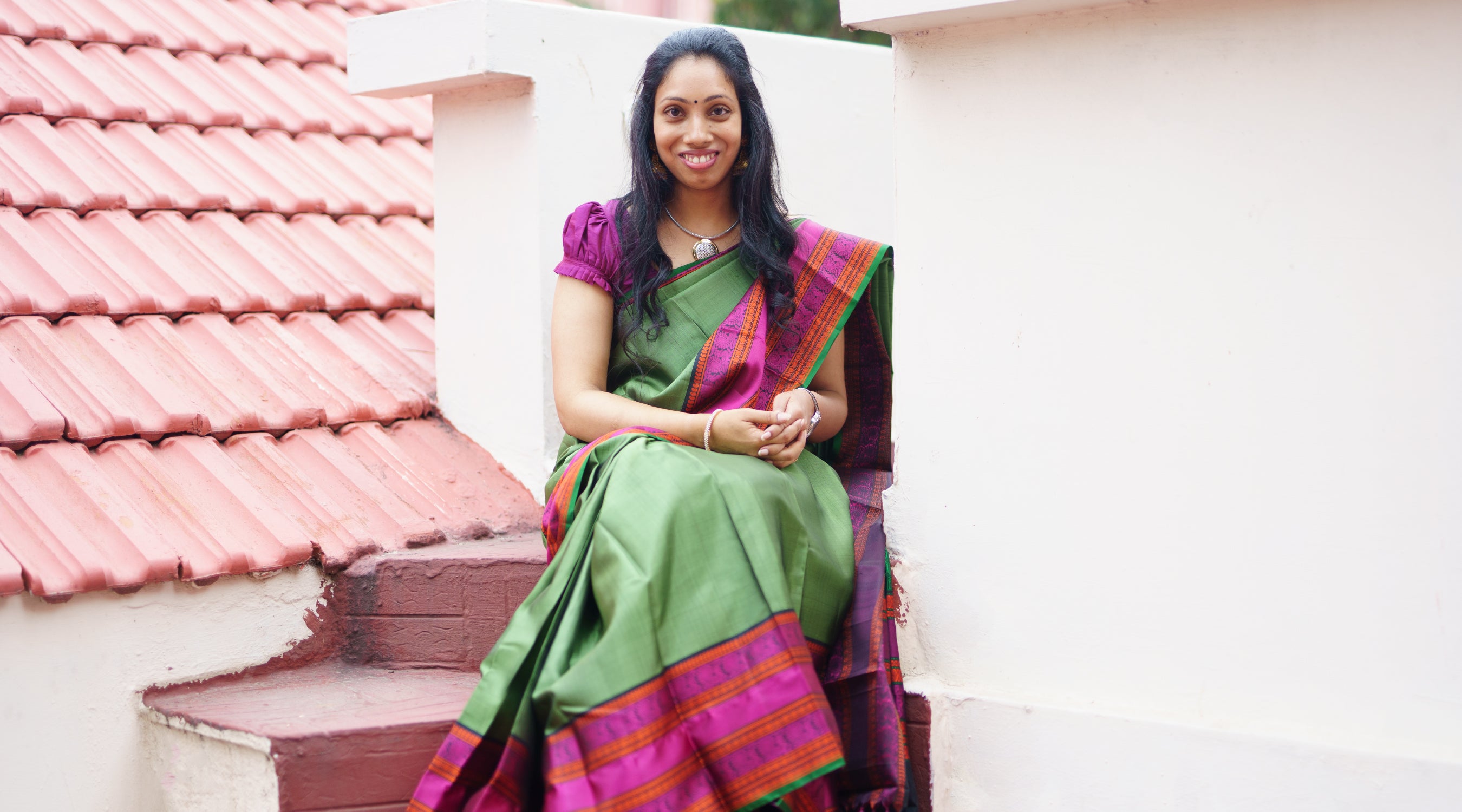KANAKAVALLI VIGNETTES : Parwathi Mirlay - Of Heirlooms and Treasures

Parwathi Mirlay, Kanakavalli’s February Vignette, loves to surround herself with beautiful things, at work and at home. Perhaps that is why a graduate in Computer Science found herself running an antique store in Bangalore, a city that is a big part of who she is. In conversation with Aneesha Bangera of The Kanakavalli Journal, Parwathi traces her journey, which weaves together elements of her training and business experience, with the passions and talents that she has both nurtured herself and inherited. Parwathi’s love for antiques is rooted in her fascination with history and design, as well as the thrill of finding beautiful pieces hidden away in back alleys or old family homes, and restoring them to their former splendour. For her, travel is a sort of self-discovery, while travel writing and photography allow her to experience and capture stories and places in new ways. As she reflects on the past and the present, contemplating traditions of beauty and her own memories of the sari, Parwathi’s warmth and joie de vivre shine through.
Taking time out of a busy schedule, Parwathi browses through the Kanakavalli repertoire to curate a selection of saris that celebrate craft, memory and beauty.
Excerpts of the conversation below…
Of Heirlooms & Treasures
What are the ways in which you have been influenced by your very illustrious family and its roots in the city of Bangalore?
Bangalore is home and my heart truly beats for this city. I realised it most acutely when I was studying abroad. My paternal grandfather Mirle N Lakshminaranappa was Advocate General of Mysore State in the 1940s; a very successful and brilliant advocate, and legal counsel to the last two Maharajas of Mysore. He came to Bangalore in the early 1900s from Mirle, a little village on the Kaveri beyond Melkote, for a better life. My maternal grandfather Dr. M Sivaram was from Malleswaram in Bangalore. He was one of the key founders of the Bangalore Medical Collage, nurtured it and then gifted it to the State. Besides being a very successful medical doctor, he contributed hugely to Kannada Literature and Kannada Humour under the pen name Ra.Shi and was a Sahitya Academy Award winner.

Above (left to right): Parwathi's maternal grandfather, Dr. M. Sivaram; Her grandfather from the Mirle side of the family with Parwathi's brother, who was the love of his life. Both her grandfathers were illustrious men whose work made a difference to the city of Bangalore, and Parwathi has followed in their footsteps.
Their lives were stories of hard work, education, discipline, integrity, compassion, sharing and giving back to society at every opportunity. Commitment to your Dharma and not straying from it no matter what, was the cornerstone of both their lives. When I look back now, I realise how deeply influenced I have been by both of them and my parents Srikanth and Leela Mirlay who led by example and passed those values down to me.

Above (left to right): Parwathi with her husband Sukumar; With her son Dhananjay.
Today my husband and I, my siblings and many of my cousins, are fortunate to work in fields that touch the lives of people in the cities we live in, in important ways. I realise how blessed we were to have had this exposure. To continue to give back to Bangalore and live by my grandparents’ timeless values is important to me.
How did you make the shift from the IT industry into the fields of travel and hospitality, and finally to the world of antiques? What have been some of the defining moments of your career?
Armed with a Masters in Computer Science from Mills College, Oakland, California, USA, I returned to Bangalore in 1990 and worked at Wipro for two years before I started Xpression - The Technical Writing Company, the first of its kind in the country. After almost two successful decades in IT, I shifted gears to slow down, take better care of our growing son Dhananjay and look inward to find my other interests.
I have always loved being on the move. I was the enthusiastic travel planner for family and friends—destination research and itineraries excited me. Unlike a career in IT this gave me the flexibility I needed. Thus was born Magic Carpet – Handcrafted Journeys, a boutique travel company that took people to unusual destinations around the world. That was an amazing decade, filled with fascinating countries, wonderful clients, history, art, music and cuisine that completely enriched my life.
Through all of these years my husband Sukumar and I had picked pieces of antique furniture to decorate our home. The beauty of old wood, workmanship, stories of where they came from and their links to history and design always fascinated us. We had no idea then that Saanchi, our antique store, was already in the making. Saanchi was our small way of giving Bangalore a space where people could enjoy colonial antique furniture, walk down memory lane, indulge in nostalgia and go home with furniture and our motto : Retrieve, Restore & Reuse.

Above: The beautiful bungalow that houses Parwathi's antique store, Saanchi, in Bangalore.
Saanchi was a huge and tough project and Magic Carpet had to sadly float away. Saanchi is five this year and the learning continues alongside the achievements. Besides Saanchi, I currently run a small beach house called SeaEsta on the Arabian Sea near Udupi. Its breath-taking beauty makes me believe I must have done something good in a previous life to set foot on that beach! Hospitality is an inheritance from my Mirlay family and comes naturally to me. My father’s sister Nanjamma and my great-grandmother were known for their hospitality and generosity. Welcoming people to SeaEsta, keeping a good home and being able to share it with others brings me joy.

Above: SeaEsta on the Arabian Sea, the gorgeous beach house near Udupi that Parwathi runs.
While travel, antiques and hospitality have a lot in common, what helped me string them all together was my experience in running my own business in IT. I owe a huge debt of gratitude to Sukumar who believed in and encouraged me. He shared his experiences and the excitement of achieving something on one’s own. What I learned in my IT business, I leverage across the board and carry that experience from one domain to another. Looking back, starting Xpression and going it alone was the most defining moment in my career simply because I don’t come from a business family. That first step is a giant one.
Where does your love for beauty and beautiful objects come from? Tell us about the ways in which your interests, hobbies, beliefs and work all feed into each other.
My mother Leela Mirlay is a beautiful, graceful and elegant woman. She wears beautiful saris, is always well turned out and kept our home very well. My aunts (her two older sisters) were artistic too. My eldest aunt Vimala Seshadri was a master of water colours and charcoal. My other aunt Kamala Ramaswamy embroidered beautifully. I have also painted in oils and sketched since I was little. I was the Art Editor for a local paper in Bangalore in the 1980s called The City Tab, in which I reviewed exhibitions and interviewed artists. My husband Sukumar has great taste and an eye for beauty. So I think these have been my influences... I like to live surrounded by beautiful things, both at work and at home.

Above: Parwathi's mother, on the extreme right, and aunts, all dressed in kanjivarams. All three deeply influenced Parwathi and her ideas of beauty.
Every person needs to express herself in some way or the other. You just have to find your path. I have always enjoyed painting, photography and writing. I wrote for 20 years as a Technical Writer and enjoyed the technology and the process. My travels made me write again as I had so many exciting stories to tell. It also gave me a chance to indulge in travel photography, which I really love. I continue to travel, write and photograph for Saanchi as antiques need all three and lend themselves to these very well.
What excites you most about working with restoring antiques? How do you go about collecting vintage objects and other treasures?
Restoring antiques is very exciting for me on many levels. When I see a piece in dusty, run down conditions, I wonder where it came from and what it must have looked like in all its glory. When you scrape a piece down, it is often like a lucky dip! What looked like paint once ended up being beautiful Jackwood studded with silver Muqaish work. Good wood is exceptionally beautiful and smells lovely too. Art, history and design influence each other in antique furniture, and this is always fascinating. Lifestyles of the past were a big influence too. Then there is the ‘technology’ of carpentry which was far superior in the past. Every piece of furniture was once crafted like a piece of art and thus was able to live on forever. And finally, there is the joy of polish that is varied and in itself an art form of sorts. It makes the whole piece come alive all over again.
I travel a lot to collect and hand pick colonial furniture for Saanchi. We have Art Deco, English, Dutch, Portuguese and French pieces, besides old Indian pieces. Sometimes pieces come from families and that makes me very happy. Any new place I go to, I spend a day roaming the back alleys and markets with my eyes wide open. Who doesn’t love a good treasure hunt?
Could you tell us about antique pieces you love that are related to clothing, dressing and beauty rituals?
We have had lots of beautiful pieces of furniture for women—dressing tables, jewellery boxes, mirrors, bridal chests and bangle boxes. I have seen some gorgeous dressing tables over the years. My earliest memory of beauty, when I was probably four or five years old, was of my beautiful aunt Nalini Nanjundiah sitting at a dressing table and putting on lipstick. I have been in love with dressing tables and lipsticks ever since!




Apart from gorgeous dressing tables, bridal chests and even antique kajal holders, we have seen some fabulous mirrors at Saanchi. We had a seven-foot stand-alone rosewood English mirror with hand turned Jacobian pillars and a grand base, that was the pride of our store for a while, till a collector from Bombay bought it. I will always remember the pangs I felt as I saw it go…

What does travel mean to you? Does your travel photography and writing change the way you experience new places?
To me travel is multi-dimensional learning combined with adventure. There is no better learning than being on the road alone. It’s probably the best way to find yourself too.
Travel photography and writing do change the way you experience new places. Photography is primarily composition and what your eye sees. With a picture you are able to convey the flavour of a place, the pace of life, the beauty of its children and elderly… You have to be in the moment and capture it forever.
I write a daily dairy when I travel to a new place. It helps me remember and string together my experiences when I return home, allowing me to see it in perspective accompanied by my pictures. The goal of writing heightens my senses and I am always hungry for the next new experience. It’s very different from when I go as a tourist without wanting to write about the journey.


Above : Images, clicked by Parwathi in Africa, from her visit to a Maasai community settlement.
How do you define beauty and tradition?
Beauty truly lies in the eyes of the beholder. I think it emerges from your soul and reflects in your eyes and in your smile. Tradition is an inheritance. It often comes with age old wisdom, science, environment, religion and lifestyle. New traditions can be made too. Tradition is often a comforting and sentimental link to practices and people who have moved on.
The traditions of beauty across the world are many and have existed for thousands of years. In India there are traditional beauty rituals practiced even today, from patterns and designs of jewellery worn for special occasions, to specific colours for saris worn at weddings in every community. In Kashmir, weddings happen in the Spring and the bride’s jewellery is made entirely of flowers! This tradition reflects the beauty of their environment.

What does the sari - and the Kanjivaram in particular - mean to you?
To me the sari embodies grace, flexibility and versatility—a beautiful garment with no stiches! For every Indian woman, memories are spun around the saris of her mother and grandmother, and mine are no different. When we were little, my sister Gowri and I loved looking at our mother’s ‘grand’ saris, trying to figure out who would inherit which ones.
My grandfather was a doctor and one of his patients was a weaver named Arasappa. He wove three identical saris for my mother and her two sisters, for their weddings. In those days the gold sari was called ‘tarbaan’, woven with pure silver threads dipped in gold. My sister always loved this sari, and wore it for her wedding. My favourite, also woven by the same weaver Arasappa, is a peacock blue tissue sari with silk and gold threads that my mother wore for her reception, and I wore for my wedding.

Above (clockwise from top left): Parwathi's sister Gowri wearing the same gold sari that their mother wore at her wedding, pictured on the top right; Parwathi in a beautiful peacock blue tissue sari at her wedding, the same sari her mother wore at her reception, pictured on the bottom left.
I believe that the kanjivaram is the queen of saris. There is no sari in this country that can hold a candle to its elegance and grandeur. For me a special moment is always a kanjivaram moment. And for the last few years it’s been a Kanakavalli moment too!
Tell us the story behind the Kanakavalli kanjivaram you've chosen to wear for the Vignettes feature.
A friend had told me about Kanakavalli a couple of years ago and on a trip to Madras I decided to stop by the Adyar store to take a look. I walked out with three saris, and this is one of them! I absolutely love Kanakavalli’s colours. The old motifs are often blended with new colours with an elegance that is hard to match. And the handloom is of the highest quality. This was the first time I saw a kanjivaram with a touch of English Pink, a silver border and no motifs. And it was love at first sight.

Parwathi is wearing an elegant kanjivaram in pale mauve shot with pearl grey, with rich silver zari bands on the borders and pallu.
- Parwathi Mirlay, in conversation with Aneesha Bangera, photography by Raghuram Vedant.
View Parwathi's accompanying guest curation here.



